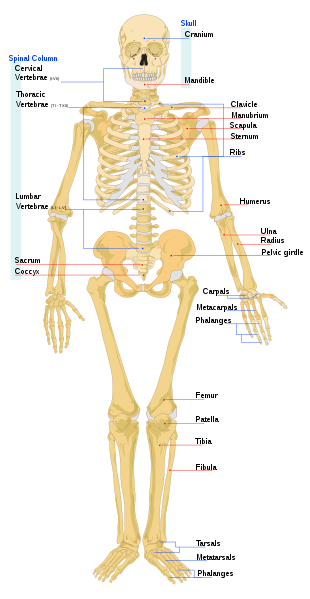CLASS: SS 1
SUBJECT: BIOLOGY PERIODS 3:
DURATION: 45 MINUTES
TOPIC: TISSUES AND SUPPORTING SYSTEMS
SUBTOPIC 1: FORMS OF SKELETAL MATERIALS
SUBTOPIC 2: TYPES OF SKELETON
PREVIOUS KNOWLEDGE: STUDENTS AND FAMILIAR WITH THE
TOPIC
OBJECTIVES: At The End Of The Period(s), students should be able to:
Period 1: Recognize different skeletal and supporting tissues.
Period 2: Mention the location and arrangement of skeletal and supporting tissues in animals.
Period 3: Draw the mammalian skeleton
REFERENCES:
Essential biology for senior secondary schools by M.C. Michael 130-135.
Modern Biology for senior secondary schools Pg. 88-89.
CONTENT
The skeleton is the bony framework of the body which provide support, shape and protection to the soft tissues and organs in animals and enable them to move and carry out their life functions.
Three major types (forms) of skeletal materials can be found in animals and they are;
- Chitin: This is a non living, tough, light and flexible materials that is a major component of the arthropod skeleton. Chitin is a carbohydrate that bears close resemblance to cellulose, the cell wall material. Chitin together with a thin water proof layer of wax form the cuticle. Chitin is often strengthened by deposits of hardened proteins and minerals. Chitin can be found in insects, prawns, crabs, scorpion etc.
- Cartilage: it is a tough and flexible tissue with great tensile strength found in complex vertebrates like sharks, rays and mammals. It consists of living cells (chondroblasts), carbohydrates and protein fibres. It acts as a shock absorber cushioning the movement of bones against one another. In cartilaginous fishes like shark, cartilage makes up the entire skeletal system but it works mostly on conjuction with bones in mammals and there are 3 types namely:
- Elastic cartilage: found in the pinnae (external ear) and the epiglottis. It serve as a support to the Eustachian tube and the external ear canal.
- Hyaline cartilage: it supports the protruding part of the nose, makes up the rings which support the trachea and bronchi and keep them open. Hyaline cartilage also covers the surface of morable joints thus preventing friction.
iii. Fibrocartilage: it is found in the disc between the small bone (vertebra) of the vertebral column. It is tougher than the hyaline cartilage.
- Bone: This tissue is the major component of the vertebral skeleton. It is a tissue because it consists of living cells (osteocytes), protein fibres (collagen) and minerals (mainly calcium phosphate and calcium carbonate). The bone is stronger and more rigid than cartilage due to the higher percentage of minerals which form two thirds of the bone mass. Bones have their own blood supply unlike cartilage which depends on the nearby tissues.
An embryo skeleton is made up of cartilage cells which is gradually replaced by bone cells as the embryo grows causing the cartilage tissue to harden into bone through the addition of minerals in a process called OSSIFICATION. Calcium is the minerals needed and the embryo gets it from the mother’s blood (calcium compounds). Vitamin D (calciferol), vitamin C, phosphorus and and magnesium are neede in addition to calcium for proper bone development.
TYPES OF SKELETON
- Hydrostatic (fluid) skeleton: This type of skeleton is found in soft bodied animals like earthworm, slug, millipede and anemones. They use fluid pressure to provide support. These animals posses a muscular body well and fluid is secreted to fill the space in the body. The fluid presses against the muscular body wall causing the muscles to contract exerting a force against the fluid. This helps to maintain the shape and form of the animal.
- Endoskeleton: This type of skeleton is found inside the body of animals. It can be found in toad, birds, lizards, mammals and in bony or cartilaginous fish skeletons. Endoskeleton in vertebrates is a combination of cartilage and bones and in mammals, the endoskeleton include the skull, vertebral column (backbone), ribs and bones of the fore and hind limbs.
- Exoskeleton: This type of skeleton is found outside of the body and is secreted by the cells covering the body of the animal. It is found in arthropods e.g prawns, crabs, insects etc. the main components of exoskeleton is chitin which is often strengthened by deposits of protein and minerals especially calcium carbonate. The exoskeleton consists of a series of plates or tubes attached at joints by sheets of unmodified chitin. This makes the exoskeleton flexible (important for movement). Muscles link the living animal to its exoskeleton.
However, because the skeleton is made up of non living materials, animals with exoskeleton moult (shed off their old exoskeleton) periodically and grow rapidly in size while the new exoskeleton is still soft and extensible. Moulting can also be referred to Ecolysis e.g. tapeworm, snail, millipede, hydraw euglena, paramecium, spider.
Skeleton diagram

INSTRUCTIONAL MATERIALS: The human skeleton
Teaching Methods procedures:
Step 1: Teacher revises the previous topic with the students
Step II: Teacher introduces the new topic by stating and explaining the three major types of skeletal materials
Step III: Teacher describe the types of skeleton found in animals
Step IV: Teacher allows the students to ask questions and writes notes under content on the boards
CLASSWORK
Period 1: Students discusses the forms of skeletal materials
Period 2: Students with the help of the teacher discusses the different types of skeleton found in animals
Period 3: Students classify different types of animals according to the type of skeleton they possess.
EVALUATION:
Period 1: What is skeleton? Give the types of skeletal materials.
Period 2: State the types of skeleton with at least two examples of animals that possess that type of skeleton.
Period 3: Explain what moulting mean?
SUMMARY: Teacher summarizes the topic, marks the students notes and makes corrections where necessary.
ASSIGNMENT(S)
Period 1: Differentiate between bone and cartilage
Period 2: Discuss the mammalian skeletal system
Period 3: Draw the human skeleton and label